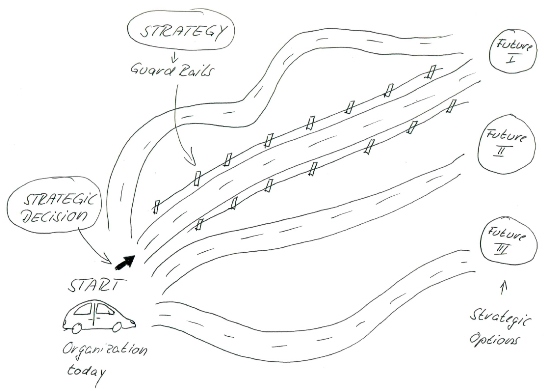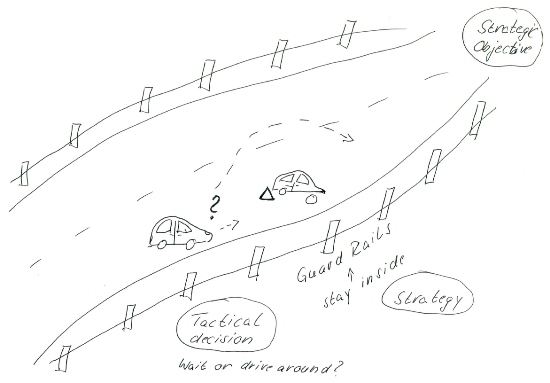Strategic decisions are decisions about an organization’s strategy. There is no doubt that strategic decisions have a major impact on any organization. However, when it comes to really strategic decision making, things tend to get a bit blurry. Not all future-oriented decisions are strategic ones. In order to develop great strategies, it is essential to comprehend the true nature of strategic decisions.
There are some characteristics that help to understand what makes a decision strategic.
General characteristics of strategic decisions
Strategic decisions usually …
- Have a long-term impact on the business
- Have an impact on the whole organization
- On its future direction
- On the scope of its activities
- On the boundaries of the firm
- Define the basis on which the firm competes or co-operates:
- Based on which competencies and / or advantages
- In which markets
- By providing which value for the customer
- Align the organization’s activities with its environment, its resources and capabilities.
Hence, strategic decisions have a major impact on the organization’s future development. They determine long-term success or failure.
From this, we can conclude some additional characteristics. These are not a prerequisite for a decision to be strategic, but they are a feature of most of them:
Strategic decisions usually …
- Are taken at top-management level
- Have a significant impact on resource allocation
- Require irreversible commitments and hence risk some sunk cost investments
- Involve major change
- Are taken under uncertainty / under incomplete information
Note: these characteristics are compiled from the following sources:
- Johnson, Scholes, and Whittington: Exploring Corporate Strategy
- Bensoussan and Fleisher: Analysis Without Paralysis: 12 Tools to Make Better Strategic Decisions
- Thinking Strategically: The Concept of Strategy and the Pursuit of Sustained Superior Profits
Frequency of strategic decisions
Many organizations have a defined strategic planning process with regular strategic planning meetings. In most cases, this is an annual cycle; sometimes with an even lower frequency. This might lead to the conclusion that strategic decisions are taken on a more or less regular basis.
I don’t want to play down the value of a regular strategic planning process. However, such a process does not necessarily lead to regular decisions that are truly strategic. The real value of such annual meetings is to review the current strategy and to make adjustments as necessary.
[bctt tweet=”An annual #strategicplanning process doesn’t necessarily lead to annual strategic decisions”]
True strategic decisions occur infrequently. They are taken when top managements identifies new opportunities or threats. Such changes of conditions don’t have a fixed time schedule. It would be unwise to postpone such a decision to the next strategic planning workshop scheduled in five months. The opportunity may be gone by then. Otherwise, it would be similarily unwise to re-cast a successful strategy, just because the annual top-management-meeting is supposed to lead to some decisions.
Distinction between strategic, tactical and operational decisions
Decisions are taken at all organizational levels. They have a varying impact on the business. In general, a distinction is made between strategic, tactical and operational decisions. Particular consideration should be given to the separation between strategic and tactical level. Depending on the terminology and the emphasis employed in the formulation, tactical decisions sometimes come masked as strategic ones.
Babette E. Bensoussan and Craig S. Fleisher define strategic, tactical, and operational decisions as follows (taken from their book Analysis Without Paralysis: 12 Tools to Make Better Strategic Decisions)
Strategic decisions
- Support the organizations vision, mission, and values
- Have significant resource allocation impact
- Set precedents for decisions further down in the organization
- occur infrequently, may be irreversible
- have a potentially material effect on the organization’s competitiveness,
- Are made by top managers
Tactical decisions
- Are less all-encompassing than strategic ones
- Involve formulation and implementing policies for the organization
- Are usually made by mid-level managers
- Often materially affect particular business functions such as marketing of production, or a business unit
- Have fewer resource implications
Operational decisions
- Support day-to-day decisions needed to operate the organization
- Take effect over a few days of weeks
- Are made by lower-level managers
- Are made frequently and often on the fly
- Tend to be highly structured, often with well-defined procedure manuals or within readily understood paramters
The following chart shall give some overview
| Typical … | Strategic Decisions | Tactical Decisions | Operational Decisions |
| Scope | Whole organization | Business functions, business units, or products | Day-to-day business |
| Change involved | Major | Medium | Minor |
| Resource implications | Major, often irreversible, risk of sunk costs | Medium, often budgeted | Minor |
| Nature | Complex
taken under uncertainty unstructured |
Less complex
Often within a particular framework More structured |
Simple, routine
Highly structured Within defined processes |
| Taken at which level | Top-management | Mid-level management | Lower-level management, operational staff |
| Frequency and time-frame | Long-term effect
Infrequent and non-recurring |
Medium-term effect
More frequent, sometimes within a regular schedule |
Short-term effect of days or weeks
frequent |
We can summarize that strategic decisions provide the framework and the guideline for all tactical and operational decisions. They all have to take into account the overall strategic objective.
For Illustration
I like to illustrate this with the analogy of guiderails on a road:
Let’s compare the organization with a car on the road.  In the beginning, the car (its driver respectively) has to decide for one of several mutual exclusive objectives. He also decides which road to follow. This is the strategic decision. It provides the guiderails for the road to follow during future.
[bctt tweet=”A strategic decision is a guardrail for the road to follow”]

The strategic decision is which objective to choose and which road to take; the guardrails are the strategy
On its way, the car encounters an obstacle; let’s say a broken car on his lane. The driver now has to decide what to do: wait for the broken car to be towed off or drive around the obstacle. His decisions will depend on two main factors: oncoming traffic and how long it will probably take for the broken car to be towed off. Whatever he does, he will never move outside the guardrails of his strategy. This is the tactical decision.

Guardrails on the road as an analogy for strategy: taktical decisions are taken within these guardrails
Later on, the driver realizes that he is short on fuel. He decides to stop at the next gas station for refueling and cleaning the windshield. This would be an operational decision. It is taken frequently within a standardized framework.
———————–
Our book recommendations on strategic decision making
- The Decision Book: 50 Models for Strategic Thinking
by Mikael Krogerus and Roman Tschäppeler
This book presents fifty models for better structuring, and subsequently understanding, life’s steady challenges. Interactive and thought-provoking, this illustrated workbook offers succinct summaries of popular strategies. - The Strategy Book: How To Think and Act Strategically to Deliver Outstanding Results
by - The Sustainability Mindset: Using the Matrix Map to Make Strategic Decisions
by Steve Zimmerman and Jeanne Bell
Drawing ontheir in-depth experience, the authors provide an easy-to-follow process complete with tools and templates to help organizationsvisualize their business model and engage in strategic inquiry.

Pingback: Early indicators in business–use with care | Themanager.org
Pingback: 2015 Roundup for Eddielogic.com and Themanager.org